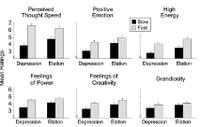Thinking Speed, Mood and Optimism

There’s a very interesting article at the Mixing Memory blog. It’s one of the blogs that I highlight in the “What I’m reading” section. The articles highlights some recent research by Emily Pronin and Dan Wegner from Princeton and Harvard respectively, entitled “Manic Thinking: Independent Effects of Thought Speed and Thought Content on Mood.”
It’s about an intriguing issue. People who have a manic illness have an acceleration of thinking processes together with elevated mood and energy level. Mania is also associated with racing thoughts grandiose or creative ideas, fast, uninterruptible speech, aimless pacing, irritability and an over-involvement in pleasurable activities, together with a loss of impulse control.
It may sound great, and initially people are often very happy to be manic. But after a while it can give way to exhaustion or the realization that some of their choices have been unwise. I once knew someone who was driving a brand new BMW – that she could definitely not afford – at over 120 miles an hour, the wrong way down Interstate 95. That’s when the police became involved, and they immediately realized that she was not a villain, but a very sick person who could have killed herself and a ton of other people.
The researchers they had a group of college undergraduates read a series of 58 emotion-inducing statements out loud, and to do it at either a fast or slow pace. The statements are emotionally neutral at the beginning and then become progressively more emotionally positive or negative. The idea is that reading a series of progressively more positive or negative statements will affect the reader’s mood. The letters in the statements were presented one at a time, either for 40 milliseconds per letter (“fast thinking” condition) or 170 milliseconds per letter (“slow thinking”). A pilot study indicated that the 40 milliseconds per letter reading time were about twice the normal reading speed for college undergraduates and 170 milliseconds were about half the normal speed. The time between statements also varied, with only 320 milliseconds between statements in the “fast condition” and 4 seconds between statements in the “slow condition.”
After reading all 58 statements, the participants were asked to answer a series of questions designed to assess their mood, energy level, feelings of power, creativity and inspiration. There were also questions to evaluate “grandiosity or inflated self-esteem,” together with their own perceptions of their speed of thought.
Subjects in the “fast thought” condition reported faster thought speeds than those in the “slower” condition. As predicted, faster thought speeds affected mood and mania-related feelings, participants in the fast thought condition reported being happier, had higher energy levels, experienced greater senses of power and creativity, and higher levels of grandiosity (though self-esteem did not differ between conditions). What is important, is that these effects were independent of the mood manipulation (positive or negative statements). Here is a graph from the paper presenting the effects of slow and fast thinking as a function of the type of sentence:

This study has some important implications. Thinking more quickly produces elevations of mood and self-perception that can smetimes be similar to those of very mild mania. I have seen this happen frequently when people have been up all night: the bright lights of morning and a few cups of coffee make them appear mildly manic. For a time they do in fact impress with their creativity and mastery not only of details, but of the “Big picture.” But as time goes on, much of their thinking turns out to be not altogether logical.
The study also raises the possibility that some manic symptoms may be produced by thinking. There is an old term from the psychoanalytic literature called “manic defense,” in which people use manic-like symptoms to protect themselves – or more accurately their ego structures – when under stress.
I have spent most of my life with people who think very quickly and accurately. Most also express themselves very well: both succinctly and fluently. But all have also known the importance of stopping for a while after a brainstorming session, so that we can see if our ideas have really born fruit, or if they just seemed a good idea at the time.
There is no question that moving and speaking more quickly can elevate our mood. It is no surprise that it has little impact on self-esteem. It is becoming more and more clear that self-esteem follows from genuine achievement. Boosting artificially is difficult, with one exception: when people have every reason to have decent self-esteem, but instead they keep feeling bad, as if they have a kind of leaky bucket as my friend the psychiatrist Stephen Preas calls it.
I remember an experiment in which an investigator was experimenting with ether. During one of his sessions he had a deeply felt mystical experience in which he was sure that he suddenly understood the whole of nature and reality. He immediately wrote it down so that he could show the world The Secret.
When he came back down to earth, he looked at what he had written, “The world is like a fish…”
“The world that we have created is a product of our thinking. It cannot be changed without changing our thinking.”
–Albert Einstein (German-born American Physicist and, in 1921, Winner of the Nobel Prize in Physics, 1879-1955
)
“Some would sooner die than think. In fact, they often do.”
–Bertrand Russell (Welsh Mathematician, Philosopher, Pacifist and, in 1950, Winner of the Nobel Prize in Literature, 1872-1970)
“Most people can’t think, most of the remainder won’t think, the small fraction who do think mostly can’t do it very well. The extremely tiny fraction who think regularly, accurately, creatively, and without self-delusion. In the long run, these are the only people who count.”
–Robert Heinlein (American Writer, 1907-1988)
Of Horses and Hearts

I live on a horse farm, so I see the interactions between horses and between horses and humans almost every day. Horses are extraordinarily sensitive creatures with their own sets of emotions and highly developed sense of propriety. They are also very good barometers for the emotional states of humans. We could not work out why one of the horses at another farm was consistently bratty with one particular rider, until we discovered that she was high on ecstasy. Her “energy” was a mess and it totally confused the horse.
On the other hand, horses are often used therapeutically with emotionally and mentally ill and handicapped children and adults. My old horse – Mr. Black – was a perfect therapy horse: nothing ever fazed him.
There is now some more research demonstrating one of the possible mechanisms by which horses may be able to pick up on a rider’s emotional states.
I have a couple of times mentioned some of the work being done at the Institute of HeartMath in California.
Some of their work is controversial, but most has been quite convincing.
I have for several years now been interested in the phenomenon of Heart Rate Variability (HRV). As the name implies, it is a measurement of the beat-to-beat variation in the heart’s rate. Alteration (primarily reductions) of HRV has been reported to be associated with various pathologic conditions like hypertension, hemorrhagic shock, and septic shock. It has found its role as a predictor of mortality after an acute myocardial infarction. It may also be disturbed in major depressive disorder.
I knew about it from the days that I worked at the National Heart Hospital in London, but Roger Callahan – the discover of Thought Field Therapy (TFT) – has been able to show that TFT is one of the few therapies that can normalize it. We also discussed it in the context of the vagal nerve and compassion.
From a pilot study by the Institute and Dr. Ellen Gehrke from Alliant University it appears that a horse’s heart rhythms reflect their emotional state and can respond to the emotional state of a nearby human. When in contact, a horse’s heart rate may mirror a human’s emotions, implying a close unspoken form of communication between the two.
The study took place at Dr. Gehrke’s ranch in San Diego, where electrocardiogram (ECG) recorders were placed on her and also on four of her horses. All five were monitored during a 24-hour period in which the horses were under a variety of normal conditions and activities such as eating, grooming or being alone. Measurements were also done while they were being ridden and accompanied by Dr. Gehrke.
The ECG recorders projected increased coherent HRV patterns for the horses during times of close, calm contact between them and Dr. Gehrke. Coherent HRV patterns have been shown to be the result of positive emotions and facilitate brain function.
Dr. Gehrke said, “Horses receive information from body language and give feedback. They don’t think very much, they feel. They are very emotional and honest. They also have a powerful impact on your sense of self and ability to lead.”
I don’t think that cardiac coherence is the whole story. They also respond to micro-movements – small movements of the legs, arms and trunk that are all but imperceptible to humans – and we have seen many of them sense events at long range. I travel a great deal and come home at odd times. But several witnesses saw Mr. Black start to become very excited 20-30 minutes before I would arrive home. In England, Rupert Sheldrake has amassed a considerable body of evidence to support those observations.
Nonetheless, this is very important research and I shall be very interested to see the final version once it has been subject to peer review.
“There is something about the outside of a horse that is good for the inside of a man.”
–Sir Winston Churchill (English Statesman, British Prime Minister, 1940-1945 and 1951-1955, and, in 1953, Winner of the Nobel Prize in Literature, 1874-1965)
“A man on a horse is spiritually as well as physically bigger than a man on foot.”
–John Steinbeck (American Writer and, in 1962, Winner of the Nobel Prize in Literature, 1902-1968)
“Wherever man has left his footprint in the long ascent from barbarism to civilization we will find the hoofprint of the horse beside it.”
–John Moore (American Man of Letters and Former Archivist and Librarian for the State of Tennessee, 1858-1929)
“I’d rather have a goddam horse. A horse is at least human, for God’s sake.”
–J.D. Salinger (American Writer, Student of Advaita Vedanta and Recluse, 1919-)
And finally:
“In my opinion, a horse is the animal to have. Eleven-hundred pounds of raw muscle, power, grace, and sweat between your legs – it’s something you just can’t get from a pet hamster!”
–Unknown Author
Chronic Fatigue, RNase Deficiency and Spiritual Development
I was very sorry to hear that Ken Wilber, whose work I admire enormously, has recently been very unwell. While weakened by an underlying chronic illness, he took a nasty fall that has left him pretty badly bruised, and with some possible neurological problems. Fortunately he is already somewhat better.
According to Ken, his underlying illness is a form of chronic fatigue syndrome called or caused by RNase-L Enzyme Dysfunction. People with the problem develop a number of bizarre symptoms apart from fatigue, including muscle weakness, fevers and immune dysfunction. The RNase enzyme is normally activated when a cell has to deal with viruses, some toxins and some bacteria. There is a good introduction here.
There is a growing literature on the subject: investigators from Brussels have recently shown a link between exercise performance and immune dysfunction in some of these patients. It may be that elevated RNase-L enzyme activity may provide us with a biological marker for some cases of chronic fatigue syndrome. Despite this research, I still have many colleagues who continue to say that chronic fatigue syndrome and a probably related condition, Chronic Fatigue and Immune Dysfunction Syndrome, are purely psychological problems.
I am quite sure that they are wrong.
Not least because there are very few illnesses that can be reduced to just psychological or just physical causes. These artificial distinctions do little to help people suffering with genuine problems. (You may be interested to have a look at a brief piece that I wrote about this artificial distinction.)
I do know that the most difficult problems that I have ever faced in clinical practice have been the chronic fatigue syndromes and a possibly related problem: interstitial cystitis. The only things that have helped have been approaches employing the five dimensional approach: physical, psychological, social, subtle and spiritual.
And now I’m going to go out on a limb and do something that normally I do not. I will normally not make even the broadest comments about someone’s diagnosis and treatment unless I’ve seen them myself: there are few things worse than people trying to diagnose at long range and when they only have half the information. But when I see symptoms like these: fatigue and fever, physical weakness and sometimes profound psychological effects, I have to ask whether the biochemical markers are actually telling us something different: that some people with these problems may actually have what used to be known as “diseases of discipleship.” An old-fashioned term used to describe some of the physical challenges and changes that may accompany spiritual evolution. If I am correct, I would predict that Ken – and many other sufferers – should also have profound disturbances of their normal circadian rhythms, some predictable but subtle endocrine disturbances, and otherwise inexplicable sensations roughly corresponding to the channels identified in Chinese and Ayurvedic medicine.
One of the most startling recent discoveries in medicine has been that some of the time-honored laws of healing are changing, because we are ourselves changing very rapidly. In Healing, Meaning and Purpose, I spent a long time talking about some of the reasons for coming to that understanding, and how to use it to improve our health and well-being. I fully expect to spend the remainder of my career showing people how these new laws and principles can help us all, as well as ensuring that appropriate research continues to help us develop these new understandings about health and wellness.
So I’m going to suggest that Ken’s problems might never have happened if he hadn’t been on such a deep spiritual quest, and if he hadn’t been turning up a lot of answers that matter.
Get well Ken!
Technorati tags: Ken Wilber Chronic fatigue syndrome RNase deficiency Chronic Fatigue and Immune Dysfunction Syndrome Interstitial cystitis Spiritual development Circadian rhythm Integrated medicine Integrative medicine Laws of Healing
Surviving Airplanes
I’m an extremely frequent flier: in an average year I fly the equivalent of ten to twelve times around the world, or all the way to the moon and part of the way back. So I’ve had to learn all the tricks for surviving countless hours in the air.
Some of them you will know already: keep hydrated, avoid alcohol, move and stretch whenever you can. I’ll soon be posting my jet-lag strategies.
But I wanted to let you know about a product that I’ve been using for years: it’s now called Yarrow Environmental Solution. I’ve certainly found that it’s been very helpful in reducing some of the exhaustion that is a common part of long haul air travel.
There is a piece of unpublished research that seems to confirm that the remedy is having a measurable effect. I wish that I had the time to do a more extensive study to see whether my observations have a scientific basis.
Current scientific models can’t explain how the flower essence could possibly work. Yet my observations and those of many students and patients are that it can be very helpful indeed. Not just to frequent fliers, but also for people who spend a lot of time in front of computer screens or under artificial light.
If you are exposed to any of these things, and find yourself constantly drained and exhausted, you may find this essence very helpful, as part of a package of Integrated Medical care.
Regular readers know that I’m most insistent on full disclosure. So I can reveal that I have absolutely no relationship with the manufacturer, other than buying bottle of their essences.
Technorati tags: Yarrow Environmental Solution Flower Essence Society Biofield Subtle energyIntegrated medicine Integrative medicine Environmental illness
Energy Medicine
"There are more things in heaven and earth, Horatio,Than are dreamt of in your philosophy." (Hamlet, Act 1, Scene V)
–William Shakespeare (English Poet and Dramatist, 1564-1616)
There has been a lot of talk recently about energy medicine, energy psychology and even energy psychiatry.
What exactly are they, and why do we believe that these therapies only have half the answer?
The National Center for Complementary and Alternative Medicine divides energy medicine into veritable and putative. I find these terms a little clumsy. By veritable they mean energies like light, sound and electromagnetism that can be measured. They use the term putative energy fields, also known as biofields, because they have not been measured in a reproducible manner. Treatments like Reiki, Qigong, Shiatsu, Healing touch, Thought Field Therapy and perhaps prayer can all be included under the heading of energy medicines.
A note of caution here. The Scientific and Medical Network, which I had the privilege of serving for a number of years, has had a high-powered study group looking into energy medicine. At its inaugural meeting, the Nobel Prize-winning Physicist Brian Josephson made the important point that we need to be careful about our definitions. Let me clarify that, and tell you why this is such an important issue.
In my book Healing, Meaning and Purpose, I reported the stunning discovery that scientists seem to have "overlooked" more than 90 percent of the universe. This missing piece is being referred to as "dark" matter and "dark" energy. We know very little about it, but some visionary scientists are already wondering if this dark matter and dark energy may have something to do with the burgeoning evidence for the existence of "subtle" systems associated with the body. These subtle systems appear to be of many types, and in Asia have been given names like Qi (Chi) and Prana, or in the West were called the Etheric or the Fifth Element, after Earth, Fire, Air and Water. Why do I say that much that these therapies have only half the answer? I prefer to use the term subtle "systems", to be a little more precise than saying "energies", for these subtle systems are composed of the inseparable twins:
1. Subtle energies and
2. The subtle fields that carry them.
Without energy the fields could not actualize, and without the fields, there would be nothing to carry the energy.
The next point is that underlying the subtle systems is the key to healing. Before even there were the subtle systems, there was an Informational matrix. This is a very scientific and clinical term for something that we also know as the Inner Light or your Inner Divine Spark. You have it: we all do. Aging, illness and death occur when this matrix degrades. Then the subtle systems become chaotic and the biochemical and cellular systems follow. When we treat someone with acupuncture or Reiki, it is not so much that we are squirting "energy" into him or her, but that we are giving that person’s whole organism some cleaned-up information that has a positive effect on the person receiving the treatment.
"Love is the immortal flow of energy that nourishes, extends and preserves. Its eternal goal is life."
–Smiley Blanton (American Speech Pathologist, Psychoanalyst, Writer and Founder {with Norman Vincent Peale} of the American Foundation of Religion and Psychiatry, 1882-1966)
Technorati Tags: More blogs about Energy+Medicine. Reiki Energy Healing
Reiki Energy Healing
Rooting Out Resistance to Change
It is never easy to change our mind about anything, as long as we remain attached to a particular belief, outcome or line of reasoning. Subsequently, we can become inflexible and intolerant of new ideas. There are several barries to emotional, personal and spiritual freedom and ATTACHMENT is one of the most potent.
In my recently released book, Healing, Meaning & Purpose: The magical power of the emerging laws of life, I discuss 12 major reasons why people resist change. They are:
- Being unaware that change is possible.
- Having entrenched belief systems.
- Having an emotional or habitual attachment to a particular way of doing things.
- Feeling comfortable about where you are.
- Fearing change or the consequences of change, like losing face or risking embarrassment or ridicule.
- Having intellectual reasons for maintaining the status quo.
- Being unaware of information to support the need for change.
- Being unconvinced by the necessity for change.
- Having blockages or perturbations in their energy fields.
- Having a life story that does not leave room for change or evolution.
- Being unaware of the rewards that flow from changing.
- Not knowing how to harness resources to accomplish change.
What are your roadblocks to emotional, personal and spiritual freedom? What is the first step in creating positive changes in your life?
Technorati tags: spiritual growth







